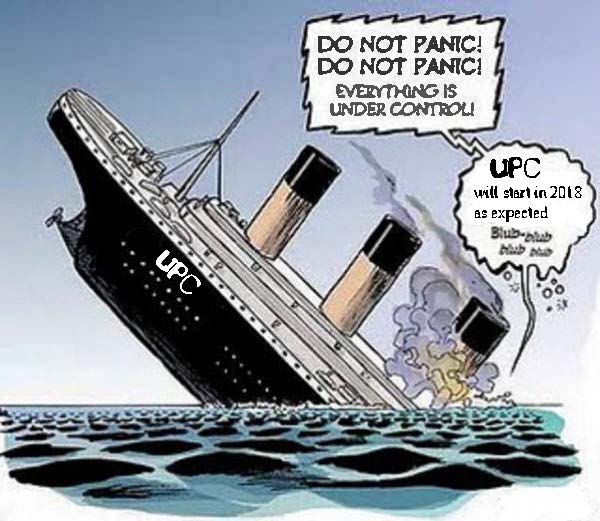

THE European Patent Office (EPO) has been turning more litigation-friendly (presumption of guilt) in recent years -- the same kind of thing that today's U.S. Patent and Trademark Office (USPTO) is quickly turning into, as we've just explained. Many if not most or even all of Team UPC are "litigation" people; they profit from legal battles, from wars...
"One judge whose last document dealt with a software patent (which he rejected) had his office raided and he was forcibly removed during office hours, causing a possible mental breakdown."What stands in the way of Team UPC is patent quality or courts that insist on quality. They therefore want the likes of Battistelli in charge; they want a high prosecution rate. They will never give up. It seems as though they're eager to undermine constitutional courts like they already did the German parliament among other parliaments.
Here's an image of how they immaturely push for a decision:

2018 has been a year of increased productivity for at least those Boards of Appeal that cover software inventions (Boards 3.5.01 and 3.5.03 to 3.5.06). In particular Board 3.5.01 has returned to a similar level of productivity as the other Boards now that it has a Chairman. The main controversies continue to be the proper treatment of mixed inventions (those involving non-technical aims or features as well as technical ones) and how to determine what is and is not technical.
[...]
Inventions in the field of computer science can in some cases derive technical character from the technical nature of the data being processed, and in other cases, from a technical improvement in processing data independently of the nature of the data itself. However, inventions where the data is too abstract, or is non-technical in nature, can fall between these two categories.
Thus, it is instructive to contrast T 2707/16 (Dynamically generating multiple hierarchies/MICROSOFT TECHNOLOGY with T 0841/16 (Business rule interface/AB INITIO). The latter case concerned a graph-based system for editing and compiling business rules where neither the nature of the data nor the alleged advantage of improved editing were considered technical. In the former case it was held that "the use of caching for dynamically generated data (i.e. the data polyarchy) with an authoritative store is a technical concept that serves as a compromise between higher scalability and fast response times for query processing on the one hand and freshness of the data on the other hand and that this goes beyond the notoriously known use of caching in general. Consequently, the Board considers that the claimed implementation achieves the technical effect of higher scalability of query processing on a server by means of a particular application of caching which reflects further technical considerations." The claims at issue, which were remitted for further prosecution, did not specify the nature of the data being searched.
Independence of the nature of the program being executed also contributed to technical character in T 2052/15 (Asychronous antivirus processing/KASPERSKY) where an increase in the responsiveness of a computer by using computing resources in an asynchronous manner was considered a technical solution to a problem.
A rare case of the implementation of a non-technical method being considered technical is T 2330/13 (Checking selection conditions/SAP). This concerned a method for checking whether selected options for a "configurable product" (e.g. a car) are consistent before manufacture. The Board considered that the term "configurable product" did not confer technical character because it did not exclude non-technical products, such as insurance policies. However they did consider that "the specific claimed bit (sub-)matrices, bit strings and steps of the method, especially those of splitting the bit matrix, forming bit strings representing the selection and restriction conditions and determining inconsistent pairs of selection conditions when performed by parallel processing, do contribute to the technical character of the invention and should be taken into account when assessing inventive step." The case was therefore remitted for further prosecution.
This recent decision from an EPO Board of Appeal is a rather satisfying development in how patentability (especially novelty) of purity claims is assessed at the EPO. This case may be seen as patentee-friendly, particularly for the pharmaceutical sector, as it likely extends protection for APIs. It will become especially important to review this case law when facing a novelty-only (Art. 54(3)) prior art document cited against a purity claim.
This decision is also likely to have implications for patenting enantiomers and proteins, as well as applications where purity of components is key: high-conductivity applications, high reflectivity surfaces, fuel cells, solar energy applications, catalysts, coatings…the list goes on!
First, a flying summary of the previous case law (T 990/96) is that a single disclosure of a compound together with a way of manufacturing it was considered a novelty-destroying disclosure for that compound in all purities. Even if the claimed level of purity was not disclosed, the EPO would draw upon the skilled person’s general knowledge of purification procedure to arrive at any other purity. To argue against this novelty objection, the applicant would face the burden of showing that the claimed purity could not be achieved – not only with the purification technique disclosed in the prior art document, but by all conventional purification techniques.